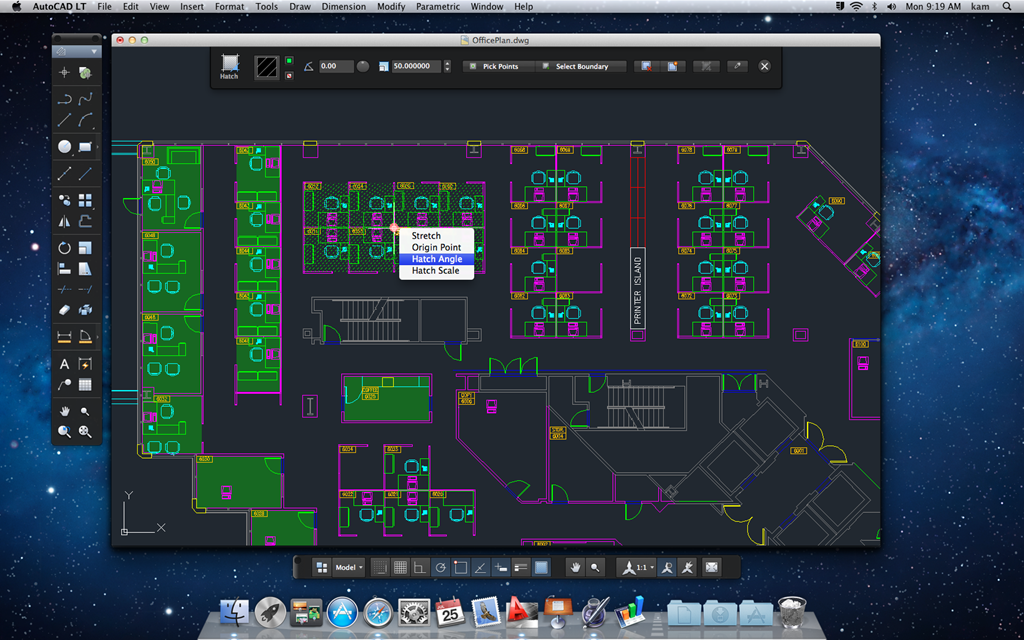
Function Syntax mljust Current Version 1.0 Download View HTML Version Donate Program Description This program enables the user to change the justification of a selection of multilines, without changing their position. Analogous to the Express Tools' TJUST command, however targeting mlines instead of text. On issuing the command syntax MLJUST at the AutoCAD command-line, the user is first prompted to specify the new mline justification, with the choice of Top, Zero, or Bottom, per the options offered by the standard MLINE command. The user may then select multiple mlines to be modified, with the program changing the justification of each selected multiline to that specified by the user, without changing the visual position of the multiline in the drawing. The program will perform successfully under all UCS & View settings, and is compatible with multilines drawn in any UCS construction plane, using any multiline style, and with any multiline scale.
AutoCAD for Mac is tailored for OS X, making it the perfect program for CAD designers who want to start drafting on their Macs. This course covers the essential features and techniques every designer needs to know to work with AutoCAD for Mac and create polished, professional drawings. Author Jim LaPier shows how to create and modify geometry, work with layers, create detailed layouts with dimensions and annotations, and plot and share drawings. The course also touches on the basics of 3D modeling in AutoCAD for Mac. Instructor. Jim LaPier is a consultant and designer at IMPACT Designs, LLC.
Jim has worked with AutoCAD for 15 years in varying disciplines, including commercial and residential architectural design, mechanical engineering, materials handling, and telecommunications. He is skilled in customization, efficiency, and speed, as well as being adept in information technology. He also worked as a genius at an Apple Retail Store, and registered as a certified Apple technician. Jim combines paper and pencil drafting knowledge with his love of cutting edge technology, both Mac and PC-based.
By: Jim LaPier course. 18m. 129 viewers. Course Transcript - Let's go back to the Draw menu and choose Multiline Text here. Unlike Dtext, where I was asked for a starting point, now I'm asked for the first and the second corner points of a window.
From here we can see the formatting is incredibly different. All the lines of text that we typed will be considered a single object. Another difference we can see is the visor that appears at the top when we edit or create Mtext. We have much more control over things like bold and italic, as well as underline and overline. Also, if we expand the visor we have even more options.

Like alignments and inserting symbols. Finally, if we right-click inside of the text area, we have even more options. Like paragraph and bullets and lists. Bullets and numbering can be quite helpful. I'm gonna choose Numbered, and now I'll type a few lines. And we can see that it automatically adds the next numbering.
About Multiline Autocad For Mac
- Multiline style creation Digitizer integration Change space Express tools7 Geographic location Autobullets and numbering Mtext match properties Mtext superscript and subscript tools. 12 AutoCAD for Mac uses ATF, but does not yet support all the formats supported by ATF on Windows.
- Program Description. This is quite a simple program, but having seen it requested quite frequently, I thought it best to include it on my site. The program will prompt the user for a selection of Multilines (MLines) and proceed to convert these to LWPolylines.
Also, if I go back up and press Return, it'll actually renumber and add lines for me. The only way to exit.
Autocad Multiline Style
Practice while you learn with exercise files. Watch this course anytime, anywhere. Course Contents.
AutoCAD for Mac. AutoCAD Map 3D. AutoCAD Mechanical. AutoCAD Mobile. AutoCAD P&ID. AutoCAD Plant 3D. AutoCAD Raster Design. Except where otherwise noted, work provided on Autodesk Knowledge Network is licensed under a Creative Commons Attribution-NonCommercial-ShareAlike 3.0 Unported License.
Introduction Introduction. 1. The Interface 1.
The Interface. 2. File Management 2.
File Management. 3. Navigation 3. Navigation. 4. Basic Geometry 4.
Basic Geometry. 5. Geometry Tools 5. Geometry Tools. 6. Modifying Geometry 6. Modifying Geometry.
7. Layers. 8.
Advanced Objects 8. Advanced Objects. 9.
Layouts. 10.
Annotations 10. Annotations.
11. Plotting and Sharing 11. Plotting and Sharing. 12. 3D Basics 12. 3D Basics. Conclusion Conclusion.
